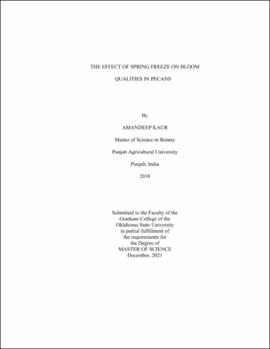| dc.description.abstract | The spring low temperature mainly targets developing buds, new leaves, reproductive organs, which are comprised of soft and fresh tissues, resulting in tremendous economic losses. Pecan is an economically important nut crop of the United States. This research was aimed to study the impact of spring freeze on pecan buds/flowers during the spring season. For this objective, different pecan cultivars were studied under artificial low-temperature conditions provided by freeze chambers as well as after the naturally occurred spring low-temperature (on April 21, 2021) in the Cimarron Valley Research Station (97 degrees 02'13" W 35 degrees 58'55" N), Perkins, OK. For the freeze chamber experiment, three pecan cultivar/rootstock combinations i.e., Pawnee/Peruque, Kanza/Giles, and Maramec/Colby were observed after 10 treatments: 5 temperatures (-6 degrees C, -2 degrees C, 0 degrees C, 2 degrees C, and 4 degrees C) each for 2 durations (4 and 8 hours). For the natural spring low-temperature experiments, 5 cultivar/rootstock combinations i.e., Pawnee/Peruque, Kanza/Giles, Kanza/Mount, Kanza/Colby, and Maramec/Colby were evaluated. The visual observation of damage in different pecan cultivar/rootstock combinations showed the same trend in both chamber and field low temperature for example in both cases Maramec/Colby showed minimum injury to buds/flowers/new leaves. Further, different methods such as FDA, H2O2, Baker's procedure were tested to check the qualities of the staminate and pistillate flowers after low-temperature treatments. The carbohydrate content from bark and wood tissues was analyzed in both of the experiments. Significant differences were observed in sugars and starch content before and after the freeze event as well as between low-temperature treated samples. In the natural spring event, the bark sugars were significantly increased after the freeze event. In the case of low-temperature treatments, it declines in most of the branches. This suggests the role and variation in carbohydrates utilization and translocation during low-temperature conditions. The gibberellins content was analyzed using the ELISA kit. Overall, this research provides information about different aspects related to spring freeze conditions in pecans. | |
